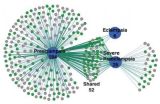(Press-News.org) PROVIDENCE, R.I. [Brown University] — Different manifestations of preeclampsia, such as early vs. late timing or typical vs. high severity, appear to have distinct genetic underpinnings, suggesting that they may need to be studied and treated differently. That and several other insights are described in a newly published comprehensive review of genetic studies of the condition, which produces life-threatening complications such as high-blood pressure in as many as 8 percent of pregnancies in the United States.
"There are probably very different phenotypes of preeclampsia and it suggests that studies focused on very particular phenotypes may be necessary to really identify the genetic architecture of the disease," said co-lead author Elizabeth Triche, assistant professor of epidemiology in the Brown University School of Public Health.
The bioinformatics insights published in the journal Obstetrics & Gynecology provide a new resource for researchers and physicians who have been trying to produce a useful genetic understanding of preeclampsia, Triche said. Within about six months, the team plans to make all the data gathered in the review available in a free, searchable database on the Web so that others can generate their own findings.
"Bioinformatic tools are great assets to identify the genetic causes of complex diseases, such as preeclampsia," said Alper Uzun, a computational biologist and bioinformatician at Women & Infants Hospital and a co-lead author on the paper.
The data come from the team's use of advanced data mining techniques to identify about 2,300 studies with information about preeclampsia genetics. Over thousands of hours, the research team of six medical students, trained to curate the papers carefully, narrowed the list to 729 articles that documented 535 maternal and fetal genes with statistically significant associations with either preeclampsia or closely related conditions.
From there the team's bioinformatics analyses uncovered networks and clusters of association among the genes. The team was able to see whether certain genes were shared or unique between mother and fetus, whether they were differently correlated with specific manifestations of preeclampsia or related disorders, and what the biological role of the key genes appeared to be.
They were also able to identify genes that were unique or shared in early- and late-onset preeclampsia. In another example, they found that 194 maternal genes are distinctly associated with preeclampsia, 39 genes are distinctly associated with severe preeclampsia, and 94 maternal genes are associated with both. Among fetuses, 204 distinct genes are associated with preeclampsia, 25 are associated with the severe form and 52 are shared between both.
In other words, the different clinical forms of the disease had distinct sets of genes involved both from the mother and the fetus.
"We were excited to see how much clustering there was [in different forms of the disease and] by maternal and fetal source," Triche said. "A lot of the research focuses typically on the mother because it's a maternal condition, but it does support the fact that the fetus plays an important role in the pathogenesis of preeclampsia."
Another key finding in the analysis was that the functions of implicated genes suggest specific biological contributions from mother and child to the development of the condition. Maternal genes that govern the response of the immune system were highly represented, while fetal genes pertaining to cell signaling, such as the molecular messages a developing baby passes to the mother via the placenta, were particularly common.
The new dataset and insights derived from it should help accelerate preeclampsia research by giving researchers a head start on the genetic combinations and biological processes at play in the different forms of the disease, Triche said.
"These more parsimonious sets of genes will allow comparison of gene-gene interactions or higher combinatorial effects with a greater degree of statistical power," she and her co-authors wrote.
The research method of compiling bioinformatics data from a systematic review of studies is a useful methodology for approaching other diseases, added co-author Dr. James Padbury, professor of pediatrics in the Warren Alpert Medical School of Brown University and pediatrician-in-chief at Women & Infants Hospital. In prior work he and Uzun amassed a similar database, for example, on preterm birth.
INFORMATION:
In addition to Triche, Padbury, and Uzun, the paper's other authors are Andrew DeWan, Itsuka Kurihara, Joy Liu, Rachel Occhiogrosso, Burton Shen, and Jeremy Parker.
The National Institutes of Health supported the research (grants: 1R21HD070177, 5T35HL094308, P20 RR018728, and P20GM103537).
Study finds genetic patterns in preeclampsia
2014-05-08
ELSE PRESS RELEASES FROM THIS DATE:
Experts say 'insourcing' innovation may be the best approach to transforming health care
2014-05-08
Philadelphia - A group of health care and policy experts from the Perelman School of Medicine at the University of Pennsylvania is urging health care institutions to look more to their own in-house personnel, including physicians and nurses, as a source of new ideas for improving how care is delivered. The practice – referred to as insourcing – relies on an organization's existing staff to drive needed transformations. The team also suggests a four-stage design process which, when adopted internally, may help organizations implement more efficient health care delivery solutions. ...
New order of marine creatures discovered among sea anemones
2014-05-08
A deep-water creature once thought to be one of the world's largest sea anemones, with tentacles reaching more than 6.5 feet long, actually belongs to a new order of animals. The finding is part of a new DNA-based study led by the American Museum of Natural History that presents the first tree of life for sea anemones, a group that includes more than 1,200 species. The report, which is published today in the journal PLOS ONE, reshapes scientists' understanding of the relationships among these poorly understood animals.
"The discovery of this new order of Cnidaria—a phylum ...
Recent Ebola outbreak highlights need for better global response
2014-05-08
WHAT:In an invited perspective article on the Ebola outbreak under way in West Africa, Heinz Feldmann, M.D., Ph.D., of the National Institutes of Health (NIH) emphasizes the need for scientists to make their data available to colleagues in real-time to improve the public health response to outbreaks. He cites past responses to influenza and SARS (severe acute respiratory syndrome) outbreaks as successful examples of global information sharing. Rapid diagnoses are key to controlling outbreaks of deadly viruses such as Ebola, for which no therapies are available. The immediate ...
Malaria severity not determined solely by parasite levels in blood
2014-05-08
WHAT:
Although malaria kills some 600,000 African children each year, most cases of the mosquito-borne parasitic disease in children are mild. Repeated infection does generate some immunity, and episodes of severe malaria are unusual once a child reaches age 5. However, the relative contributions of such factors as the level of malaria-causing parasites in a person's blood—parasite density—to disease severity and to development of protective immunity are not well understood.
To clarify these issues, researchers from the United States and Tanzania regularly examined 882 ...
Berkeley Lab develops nanoscope to probe chemistry on the molecular scale
2014-05-08
For years, scientists have had an itch they couldn't scratch. Even with the best microscopes and spectrometers, it's been difficult to study and identify molecules at the so-called mesoscale, a region of matter that ranges from 10 to 1000 nanometers in size. Now, with the help of broadband infrared light from the Advanced Light Source (ALS) synchrotron at the U.S. Department of Energy's Lawrence Berkeley National Laboratory (Berkeley Lab), researchers have developed a broadband imaging technique that looks inside this realm with unprecedented sensitivity and range.
By ...
Common drug may help treat effects of muscle disease in boys
2014-05-07
MINNEAPOLIS – A drug typically prescribed for erectile dysfunction or increased pressure in the arteries may help improve blood flow in the muscles of boys with Duchenne muscular dystrophy, according to a study published in the May 7, 2014, online issue of Neurology®, the medical journal of the American Academy of Neurology.
Duchenne muscular dystrophy is a progressive and fatal muscle disease affecting boys and young men that causes loss of muscle function. There is no specific treatment for the disease, which is genetic. Corticosteroids can slow muscle degeneration ...
Multidimensional frailty score helps predict postoperative outcomes in older adults
2014-05-07
A multidimensional frailty score may help predict postoperative outcomes in older adults.
More than half of all operations are performed on patients 65 years and older in the United States. Frail elderly patients who undergo surgery are more likely to have postoperative complications. But tools to estimate operative risk have their limitations because they often focus on a single organ system or solitary event. In geriatric medicine, the comprehensive geriatric assessment (CGA) is widely used to detect disabilities and conditions associated with frailty. The authors sought ...
Kaiser Permanente study finds radiation best treatment for a rare skin cancer
2014-05-07
OAKLAND, Calif. May 7, 2014 — Radiation treatment can help reduce the recurrence of Merkel cell carcinoma, a rare and aggressive skin cancer, while chemotherapy does not appear to have any impact on recurrence or survival, according to a Kaiser Permanente study published online in the current issue of JAMA Dermatology.
The study presents one of the largest single-institution datasets on Merkel cell carcinoma, which occurs in about 1,500 people in the United States annually. Most such cancers occur on the sun-exposed skin of white males and are first diagnosed at age 75, ...
Official statement by ACS: Release of National Climate Assessment demands action
2014-05-07
WASHINGTON, May 7, 2014 — Yesterday's release of the third National Climate Assessment (NCA) should serve as a claxon call for policymakers and the general public to take action to address and mitigate the observable and documented adverse climate disruption impacts being observed in every region and key economic sector of the United States.
These impacts, which have been observed and measured, are wreaking havoc with our society. This is a not a theoretical assessment; this report cites changes we are all observing and with which we are living. The future climate ...
A lab in your pocket
2014-05-07
When you get sick, your physician may take a sample of your blood, send it to the lab and wait for results. In the near future, however, doctors may be able to run those tests almost instantly on a piece of plastic about the size of credit card.
These labs-on-a-chip would not only be quick—results are available in minutes—but also inexpensive and portable. They could be used miles from the nearest medical clinic to test for anything from HIV to diabetes. But as powerful as they may be, they could be far better, says Shiyan Hu, an associate professor of electrical and ...



